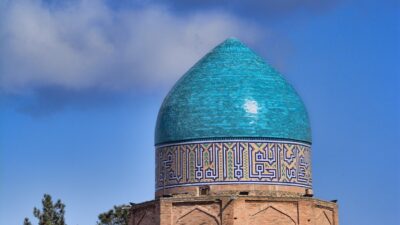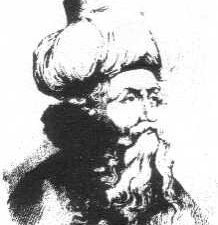The end of the Nuṣayri Assad regime in Syria in December 2024 has brought renewed focus to the sect’s history and beliefs. This article examines the origins of the sect, its key doctrines and practices, and the historical circumstances that enabled their rise to power.
Origins
The Nuṣayris predominately reside in the coastal regions of Syria. With a population of two million, they constitute roughly 10 percent of the Syrian population. The sect was founded by Muhammad ibn Nusayr (died approx. 868 CE), a contemporary of the 10th and 11th Shia Imams, Ali al-Hadi and Hasan al-Askari. Ibn Nusayr claimed that the eleventh Imam al-Askari was Allah and that he was appointed as his prophet. After his death Ibn Nusayr’s followers travelled to Syria, where they successfully converted local Christians to their new religion.
Creed
There is no God but Ali
Their creed centres on the deification of Ali ibn Abi Talib, whom they consider to be Allah. They hold that Ali is not a human but a divine appearance in human form and is superior to Prophet Muhammad (salalahu alaihi wa sallam).
In a similar vein to Christians, Nuṣayris believe in three divine beings:
- Aliis the maʿnā (essence/meaning), and is considered to be God himself.
- Muhammad(salalahu alaihi wa sallam) is the ism (name/veil), created from Ali’s divine light, hiding the essence.
- Salman al-Farisiis the bab (gate). He is the intermediary leading to Muhammad (the name), and ultimately to Ali (the essence).
The Nuṣayris believe that before Ali’s caliphate, Allah manifested himself through six other people beginning with Prophet Adam and continuing through various prophetic figure include Prophet Isa.
Not content with merely imitating the Christian concept of trinity, the Nuṣayrīs took it one step further. In a direct insult to the best of people after the prophets, the Nuṣayrīs invented a counter-Trinity—a “Satanic triad” composed of Abu Bakr, Umar, and Uthman.
Reincarnation
The Nuṣayris believe that at the beginning of time, there was a pure world of light, and God was praised by his enlightened creations. Due to their sins these souls fell from the world of light to the material world, where they were given human bodies. When a person dies, his soul leaves the body and moves to another body. It could be a human body, plant, insect, or inanimate object, depending on the person’s actions and faith in Ali. Evil souls assume the forms of unclean animals, like pigs, and dogs, while the soul of the righteous (i.e. Nuṣayris) will enter human bodies more perfect that their own. Only through a study of mystical knowledge can one can return to the pre-fall state in the world of light.
Rituals

The most important Nuṣayri ritual is the quddās, which can be translated as “mass”. This ceremony involves the consumption of wine, often alongside bread, similar to the Christian Eucharist.
Wine is holds deep symbolic meaning to the Nuṣayris. It is believed to represent Ali ibn Abi Talib, and is considered a manifestation of divine light. At the end of the mass, they curse Abu Bakr, Umar and Uthman.
Besides the use of wine, several Nuṣayri festivals further distinguish them from Islam.
- Nawruz: (Persian New Year)
- Mihrajan: Another pre-Islamic Persian festival celebrated in the autumn.
- Christmas: While they utilize the Quranic narrative of Prophet Jesus’ birth, they connect it to their beliefs about the divinity of Ali. A prayer from this feast describes Ali manifesting as a child on Christmas Eve, demonstrating his eternity and divinity, along with Prophet Muhammad (his “Name”) and Salman al-Farisi (his “Gate”).
- Ashura with a Twist: Nuṣayris celebrate Ashura as a day of joy. They believe that Husayn, like Jesus, was not truly killed but ascended to heaven.
Ruling on their disbelief
Sheikh al Islam Ibn Taymiyyah (d. 1328) issued a juristic opinion condemning the Nusayris as non-Muslims. He stated,
“These people named “Al-Nusayriyyah”, and other groups from among the Qaraamitah and Baatiniyyah, are greater disbelievers than the Jews and Christians. Nay, they are greater disbelievers than most of the mushrikeen and their harm to the Ummah of Muhammad, sallallahu alaihi wa sallam, is greater than the harm of the disbelievers who are in war with Muslims, such as at-Tatar, disbelieving Europeans and others.
For they present themselves in front of ignorant Muslims as supporters and advocates of Ahl ul Bayt, while in reality they do not believe in Allah, or the Messenger, or the Book, or [Allah’s] orders, or prohibitions, or reward, or punishment, or Paradise, or Fire, or in one of the Messengers before Muhammad, sallallahu `alaihi wa sallam, or in a religion from among previous religions. Rather, they take the words of Allah and His Messenger, known to the scholars of Muslims, and they interpret them based on their fabrications, claiming that their interpretations are “hidden knowledge (“ilm `ul-baatin”).
They have no limit in their unbelief with regards to Allah’s Names, His verses, and their distortion of the Speech of Allah, the Most High, and His Messenger from their proper places. Their aim is repudiation of Islamic Beliefs and Laws in every possible way, trying to make it appear that these matters have realities that they know, such as that “five prayers” means knowledge of their secrets, “obligatory fast” hiding of their secrets, and “pilgrimage to Bayt al-`Atiq” visit to their shaikhs, and that the two hands of Abu Lahab represent Abu Bakr and Umar.”1
The French connection
During its illegal occupation of Syria (1920-1946) France employed a “divide and rule” strategy, exacerbating sectarian tensions to maintain control over Syria. Taking full advantage of this, the Nuṣayris sought and obtained the establishment of their own independent state, the “State of the ʿAlawīs” (1920–1936).

A 10-piastre Syrian stamp used in the Alawite State, bearing an overprint overprinted “ALAOUITES” Unknown author – scanned by User:Stan Shebs in 2005-05
As part of their efforts, the French administration even altered the sect’s name from Nuṣayri to Alawi (or Alawites), hoping to highlight a perceived link to Ali ibn Abi Talib and thus integrate them more closely with mainstream Islam.
Furthermore, France established a locally recruited military unit called the Troupes Spéciales du Levant (Special Troops of the Levant). This force demonstrated loyalty to the French state and subsequently became the foundation for both the Lebanese and Syrian armies. Sunni Muslims generally avoided enlisting their sons in the Troupes Spéciales du Levant, considering it a tool of French colonial occupation.
The Nuṣayris on the other hand, with French encouragement, actively joined the military, perceiving it as a path to financial stability and upward social movement. Consequently the Syrian military under French colonial rule was dominated by Nuṣayris. This trend continued after Syria gained its independence from France. By 1955, approximately 65% of non-commissioned officers in the Syrian army were Nuṣayris.
The Ba’athists take power
Although the French occupation created the conditions for a significant Nuṣayri presence in the military, it was the Ba’ath movement that provided the Nuṣayris with the means to attain political power and eventually take control of the state.
Established in 1940 by a Christian philosopher called Michel Aflaq, the Ba’ath Party was a secular Arab nationalist movement explicitly designed to exclude religion from political life. Its members included secular Sunnis, Druze, Christians and Nuṣayris.
During the 1950s, a distinct shift began to occur within the Ba’ath party’s internal structure. While the party’s initial leadership was largely civilian, a powerful and secret military faction, composed of a significant number of Nuṣayri officers, began to emerge. This military wing began to exert considerable influence within the party and was instrumental in the 1963 military coup. The coup dramatically strengthened the Nuṣayris’ position within both the political and military spheres of Syria in three ways:
- Firstly, officers deemed disloyal to the new regime were purged, resulting in a substantial increase in Nuṣayri representation within the military leadership.
- Secondly, Nuṣayris were promoted to critical positions within the government and the state’s security apparatus, granting them control over key levers of power.
- Finally, and perhaps most importantly, Nuṣayri influence within the ruling Ba’ath Party allowed them to control political decisions and national policy.
The rule of the Assad clan
The 1963 coup brought the Ba’ath Party to power. It also marked a significant shift in the Ba’ath Party itself, as the military wing, and particularly the Nuṣayri officers within it, gained dominance over the civilian leadership. One of the coup leaders was a 33-year-old Nuṣayri air force commander called Hafez al Assad. In 1966 Assad was appointed as Minister of Defence. This position gave him control over the Syrian armed forces. With his network of loyal Nuṣayri officers and support from the Soviet Union, Assad was able to seize power in a coup in 1970.
Following the 1970 coup, Hafez al-Assad implemented policies that further consolidated Nuṣayri power. He placed Nuṣayris in crucial positions throughout the state apparatus, including high-ranking roles in the military, the intelligence agencies, and various government ministries.
Nuṣayris were provided with preferential treatment in terms of access to jobs, the awarding of government contracts, and political appointments, effectively establishing a patronage system that cemented their loyalty to his regime. The Nuṣayris accumulated significant wealth strengthening their position within Syrian society, at the expense of the increasingly marginalized Sunni majority.
The axis of betrayal
Hafez al-Assad was keen to portray himself as a leading critic of Western influence in the Middle East and a staunch supporter of the Palestinian cause. This public stance formed a cornerstone of his regime’s legitimacy, and bolstered his anti-imperialist credentials.
However, in contrast to this public image, Assad pursued an opportunistic foreign policy, readily sacrificing principle for political gain. Assad’s alliance with Christian militias against the Palestinians during the 1976 Lebanese Civil War was a profound betrayal of the Palestinians. His siege of Tel al-Zaatar refugee camps, where thousands of Palestinian civilians perished, stands as a chilling testament to his willingness to sacrifice Palestinian lives for his own political ends. This hypocrisy was further underscored by his support for the 1991 US-led invasion of Iraq. Assad saw a strategic opportunity to weaken a rival Ba’athist regime and enhance Syria’s regional power. Despite his previous condemnations of US interventionism, he readily joined the coalition, sending Syrian troops to participate in the military campaign against Iraq.
Hafez al-Assad died in June 2000. The reins of power were transferred to his son, Bashar al-Assad who initially presented himself as a liberal and non-sectarian leader. In reality however his rule perpetuated the policies of his father, maintaining the system of Nuṣayri dominance until its collapse on December 8, 2024.
Summary
With a theology that incorporates elements of Shi’ism, Zoroastrianism, Christianity, and mystical thought, the Nuṣayri religion stands apart from Islam. Their rise to power in Syria occurred intitially through their involvement in the military and then later through the secular Ba’ath Party. The process began during the French occupation in the 1920s and culminated in Hafez al-Assad’s seizure of power in 1970.
References
Talhamy, Yvette, ‘Chapter 12 The Alevīs and ʿAlawīs.’, in Handbook of Islamic Sects and Movements, 2021, ed Muhammad Afzal Upal (Brill, 2021), pp.279-304
McHugo, John, Syria: a recent history (Saqi Books, 2015)
Trivedi, Devin. Primer on the Alawites in Syria. (Foreign Policy Research Institute) fpri.org/article/2016/12/primer-alawites-syria/
mahajjah.com/the-nusayris-an-extremist-shii-sect/
Landis, Joshua, ‘How the Assad dynasty brutally ruled Syria for 54 years’ https://www.youtube.com/watch?v=7_2Gy44z7ys
- https://shaykhulislaam.wordpress.com/2009/08/13/ruling-on-the-nusayrialawi-sect/ ↩︎






Very Informative Cousin Farasat from Khalid Walsall i can see you have put a lot of effort and time in this research very well done Cousin.